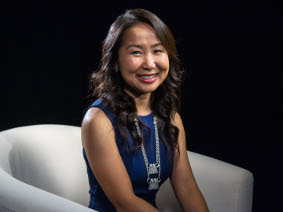
Mai Lee Chang
NASA Engineer
Contents
Personal Essay
As a child, I did not envision working for NASA or becoming an engineer. I was born in the Ban Vinai Refugee Camp in Thailand, the oldest of four children. My family and I were refugees of the Vietnam War and settled in the U.S. in 1992 in Fresno, CA when I was six years old. I started school only knowing one English word – “restroom”.
As I helped my parents pick vegetables in the California fields, I remember telling myself that I definitely do not want to continue this type of work in the future. Reflecting back, it was this work at a very young age, which made me realize that education is paramount to my future. Moreover, the sacrifices that my grandparents, parents, and many Hmong made in the Vietnam War in order for me to have a chance at a better life inspire me to achieve at the highest level. They had to dodge bullets and all I had to do was excel in school – the difference is immeasurable. This understanding, helped me excel in school, especially in math and science.
During my senior year at Oshkosh North High School, my physics teacher, Mr. Douglas Michie, asked me what I plan on studying in college. Through our conversations, I revealed I was undecided but something with math and science. He suggested, I research a career in engineering. After searching, I found aerospace engineering to be the most interesting, and I’m forever grateful for that conversation with Mr. Michie.
During my freshman year at the University of Wisconsin-Madison (UW-Madison), I became active in the Microgravity Team which competes in NASA’s Reduced Gravity Education Flight Program. My team’s proposal was selected and we traveled to NASA-JSC to conduct our experiment aboard the C-9 microgravity aircraft. After touring NASA-JSC facilities and speaking to the engineers, I knew there was no turning back! It was so inspiring that NASA was making advancements in space exploration, tackling difficult challenges, and enhancing life on Earth (still find this inspiring today!).
My career with NASA started in 2006 as a co-op student at JSC. During my undergrad, I completed five co-op tours in various engineering divisions, which helped me decide to pursue graduate school. I also had a strong interest in learning about other cultures and gaining a global perspective, so I studied abroad twice (Toulouse, France and Chiang Mai, Thailand). During my Master’s program, I completed one graduate co-op tour in the Human Systems Engineering & Development division. After graduating, with my Master’s in Industrial and Systems Engineering from UW-Madison in 2012, I joined NASA full time.
In my current job, I perform research and technology development in the fields of human-robot interaction and human-automation interaction. Understanding how humans can collaborate with robots and automation and how this affects the design of advanced automation and robotics systems is critical for our journey to Mars and other destinations. I am a part of the International Space Station (ISS) Flight Crew Integration team. I help ensure that science experiments meet human factors requirements to maximize the time available for astronauts to conduct science research onboard the ISS – a critical step towards our journey to Mars. In addition, I am a part of the Orion Human Engineering team helping ensure that human abilities and limitations are incorporated into the design of the Orion spacecraft. The team is working towards Orion’s first manned test flight – very exciting!
NASA’s history, especially the Apollo missions, inspires me to want to help write the next chapter of manned space exploration. After all, at the heart of space exploration is the human experience. I have learned that even if you start at the bottom, you can still achieve your dreams. Despite the odds that were stacked against me such as an initial language barrier and cultural clashes, my circumstances did not define my path. Instead, I chose to turn stumbling blocks into stepping stones and to dream big to work for one of the best agencies in the world – NASA.
Biography
Mai Lee Chang did not envision becoming a NASA engineer, growing up. At the age of six, she along with her family, settled in the U.S. as refugees of the Vietnam War. In fact, when she started elementary school, the only English word she knew was “restroom”. During her senior year in high school, her physics teacher suggested that she look into engineering as a potential college major. Mai Lee received a B.S. in Engineering Mechanics and Astronautics along with a Certificate in International Engineering and a M.S. in Industrial and Systems Engineering from the University of Wisconsin-Madison in 2012. Mai Lee is an engineer at NASA-Johnson Space Center within the Human Systems Engineering & Development Division since 2012. She started her career at NASA as a co-op student in 2006. She performs research and technology development in the fields of human-robot interaction and human-automation interaction. Mai Lee contributes greatly to NASA’s journey to Mars mission by understanding how humans collaborate with robots and automation; and how it affects the design of advanced automation and robotics systems. She is a part of the International Space Station (ISS) Flight Crew Integration team ensuring that science experiments meet human factors requirements. This helps maximize the time available for astronauts to conduct science research onboard the ISS. In addition, she is a part of the Orion Human Engineering team helping ensure that human abilities and limitations are incorporated into the design of the Orion spacecraft. The team is working towards Orion’s first manned test flight – very exciting! In her free time, she enjoys traveling and volunteering for Engineers Without Borders. Throughout her career, her parents and grandma played a critical role. They taught her to dream big and also taught her the language of hard work and perseverance and emphasized the importance of an education.



























